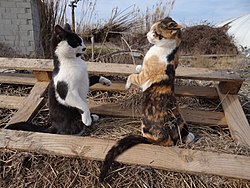Ritualized aggression or ritualized fighting is when animals use a range of behaviours as posture or warning but without engaging in serious aggression or fighting, which would be expensive in terms of energy and the risk of injury. Ritualized aggression involves a graded series of behaviours or displays that include threatening gestures (such as vocalizations, spreading of wings or gill covers, lifting and presentation of claws, head bobbing, tail beating, lunging, etc.) and occasionally posturing physical actions such as inhibited (non-injurious) bites.

This behavior is explained by evolutionary game theory.[1]
Examples
editCats
editDomestic cats (Felis catus) are very territorial and defend their territories with ritualized body posturing, stalking, staring, spitting, yowling and howling.
Spider monkeys
editSpider monkeys (genus Ateles) defend their territory by screams, barks, rattling or dropping branches, and urinating and defecating on intruders below.[2][3]
Oscar cichlids
editOscar cichlids (Astronotus ocellatus) are able to rapidly alter their colouration, a trait which facilitates ritualised territorial and combat behaviours amongst conspecifics.[4] Individuals of another cichlid species, the blunthead cichlid (Tropheus moorii), defend their feeding territory with a display, quivering the tail and fins to intimidate, or an attack, darting at the intruder and chasing them away.[5] Astatotilapia burtoni cichlids have similar displays of aggressive behaviour if they are territorial, which include threat displays and chasing.
Ring-tailed lemur
editMale ring-tailed lemurs have scent glands on their wrists, chests, and in the genital area. During encounters with rival males they may perform ritualized aggression by having a "stink fight". The males anoint their tails by rubbing the ends of their tails on the inside of their wrists and on their chests. They then arch their tails over their bodies and wave them at their opponent. The male toward which this is directed either responds with a display of his own, physical aggression, or flees. "Stink fights" can last from 10 minutes to one hour.[6]
Creek chub
editThe creek chub (Semotilus atromaculatus) engages in ritualized aggression when others of the species invade its territory. Engaging in parallel swimming, the fish widens its fins and mouth and swims at a caudal fin beat. Intimidating opponent fish throughout these rituals, the forward fish stops and directs blows to the head of the other fish to ensure territory dominance.[7]
See also
editReferences
edit- ^ Maynard Smith, John (1974). "The theory of games and the evolution of animal conflicts". Journal of Theoretical Biology. 47 (1): 209–221. doi:10.1016/0022-5193(74)90110-6.
- ^ Carpenter, C.R. (1935). "Behavior of red spider monkeys in Panama". Journal of Mammalogy. 16 (3): 171–180. doi:10.2307/1374442. JSTOR 1374442.
- ^ Regoniel, P. (2009). "Five Notable Territorial Animals". Archived from the original on June 28, 2013. Retrieved June 24, 2013.
- ^ Beeching, S.C. (1995). "Colour pattern and inhibition of aggression in the cichlid fish Astronotus ocellatus". Journal of Fish Biology. 47: 50–58. doi:10.1111/j.1095-8649.1995.tb01872.x.
- ^ Kohda, M (1991). "Intra- and interspecific social organization among three herbivorous cichlid fishes in Lake Tanganyika". Japanese Journal of Ichthyology. 38 (2): 147–163. doi:10.1007/BF02905540. S2CID 82938404.
- ^ Cawthon Lang, K.A. (2005). "Primate Factsheets: Ring-tailed lemur (Lemur catta) Behavior". Wisconsin Primate Research Center (WPRC). Retrieved June 29, 2013.
- ^ Ross, M.R. (1977). "Aggression as a social mechanism in the creek chub (Semotilus atromaculatus)". Copeia. 1977 (2): 393–397. doi:10.2307/1443928. JSTOR 1443928.